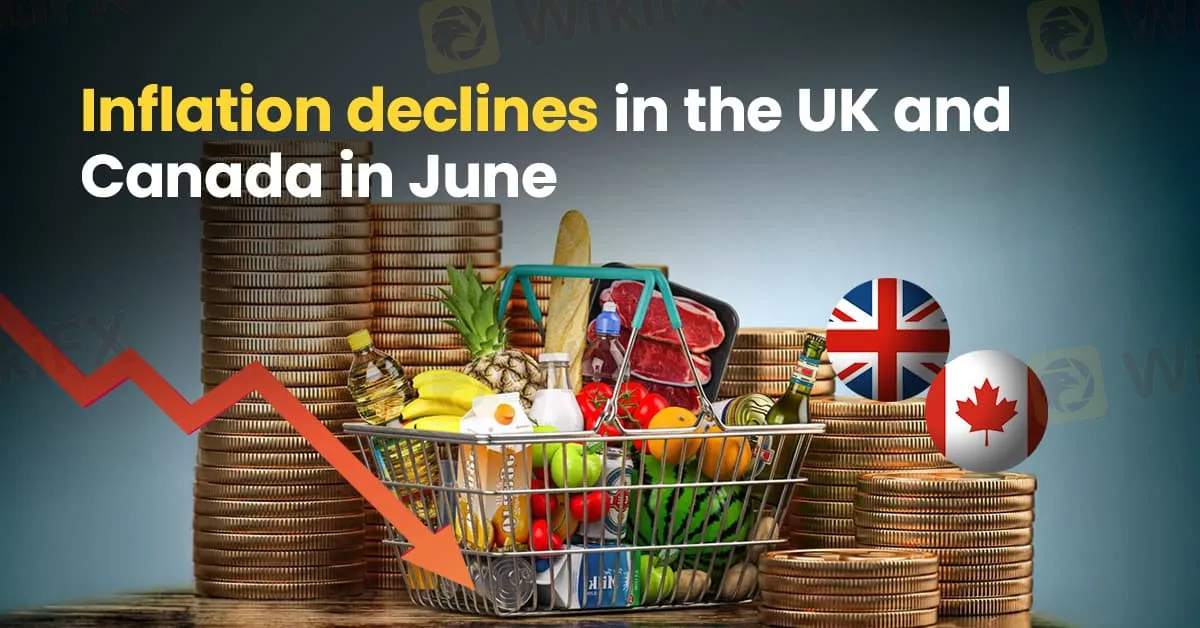简体中文
繁體中文
English
Pусский
日本語
ภาษาไทย
Tiếng Việt
Bahasa Indonesia
Español
हिन्दी
Filippiiniläinen
Français
Deutsch
Português
Türkçe
한국어
العربية
Inflation declines in the UK and Canada in June
Abstract:In June, both Canada and the UK experienced a notable decline in inflation rates. This trend aligns with the broader global movement toward lower inflation. The British Pound (GBP) rose sharply against the US Dollar (USD), while Canadian benchmark stock indices showed significant gains.

In June, both Canada and the UK experienced a notable decline in inflation rates. This trend aligns with the broader global movement toward lower inflation. The British Pound (GBP) rose sharply against the US Dollar (USD), while Canadian benchmark stock indices showed significant gains.
Inflation Falls in The UK
In the UK, a positive inflation report pushed the British Pound higher. The CPI remained at 2% year-on-year, unchanged from June, which aligns with the Bank of Englands (BoE) inflation target. Core CPI also remained steady at 3.5% year-on-year. Every month for June, CPI dropped from 0.3% to 0.1%, while core CPI eased from 0.5% to 0.2%.
However, UK services inflation remained unchanged in June at 5.7% year-on-year, nearly three times the BoE‘s inflation target. This persistent high services inflation could complicate the BoE’s plans to lower interest rates.
Inflation Falls in Canada
Canadas Consumer Price Index (CPI) rose by 2.7% year-on-year in June, down from 2.9% in May, matching a three-year low from April. Monthly, CPI posted a 0.1% decline, a sharp drop from the 0.6% increase in May. This was the first monthly decline of the year, primarily driven by a significant reduction in gasoline prices.
However, Core CPI, which excludes food and energy prices, rose by 1.9% year-on-year, slightly up from 1.8% in May. Despite this increase, it remained below the Bank of Canadas (BoC) inflation target of 2%.
Conclusion
These inflation reports indicate a continuing disinflationary trend, which supports the case for interest rate cuts. The Bank of Canada has already lowered rates in June, and it is likely only a matter of time before the Bank of England follows suit.
The USD/CAD currency pair showed little movement in response to the inflation release, while the GBP/USD pair experienced strong gains of 0.52% and 0.67% respectively following the inflation reports.
On the stock market, Canadian benchmark stock indices climbed sharply while UK indices showed a slight decline. The S&P/TSX (Canada) surged 1.07% on Tuesday, rising 243 points to close at 22,995. In contrast, the FTSE 100 (UK) fell by 28 points (0.36%) to 8,136 on Wednesday.
These developments reflect the mixed reactions in financial markets to the evolving inflation landscape in both countries.

Disclaimer:
The views in this article only represent the author's personal views, and do not constitute investment advice on this platform. This platform does not guarantee the accuracy, completeness and timeliness of the information in the article, and will not be liable for any loss caused by the use of or reliance on the information in the article.
Read more

Why Fed Keeps Interest Rates Unchanged, How Does It Affect To Forex Market?
Fed keeps interest rates at 4.25%–4.50%, impacting forex market. Dollar may rise as tariffs loom. Explore why rates unchanged and forex effects.

Do Tariffs Refueling Inflation? Understanding the Connection
Investigate how tariffs impact inflation. Learn how trade barriers influence prices and the broader economic landscape.

Will Trump's Trade Policies Fuel Inflation? BlackRock Warns of Economic Risks
Bitcoin and crypto prices plummet as recession fears and inflation warnings shake markets. Experts warn of prolonged economic challenges ahead.

How Will Central Bank Digital Currencies Could Shape Everything?
Central bank digital currencies (CBDCs) could reshape financial stability, addressing inflation, banking risks, and monetary policy challenges.
WikiFX Broker
Latest News
The Withdrawal Trap: How Scam Brokers Lure Victims into Paying More
FCA to Investors: Think Twice Before Trusting These Brokers
Trump\s tariffs: How could they affect the UK and your money
Trump gambles it all on global tariffs he\s wanted for decades
TradingView Brings Live Market Charts to Telegram Users with New Mini App
Trump tariffs: How will India navigate a world on the brink of a trade war?
Interactive Brokers Launches Forecast Contracts in Canada for Market Predictions
Authorities Alert: MAS Impersonation Scam Hits Singapore
IG Group Acquires Freetrade for £160M to Expand UK Investment Market
U.S. March ISM Manufacturing PMI Released
Currency Calculator







